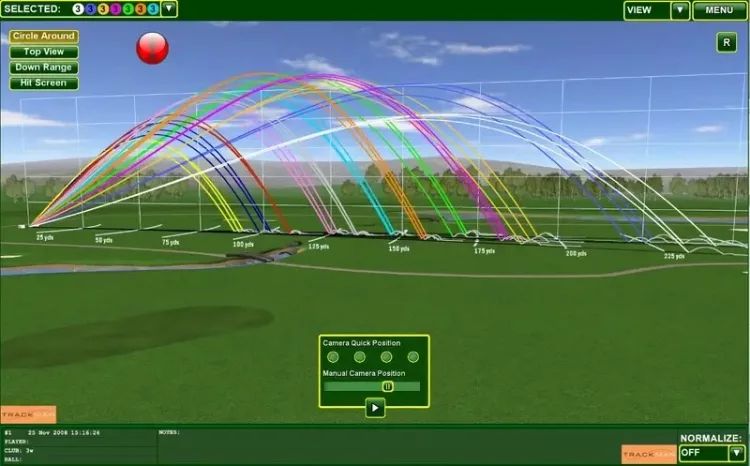Golf Wedge Distances (48, 50, 52, 54, 56, 58, 60 Degrees Chart, Loft, and Bounce)
by Bill Winters
Golf has been a popular game for as long as anyone can remember. Even then besides the golf player themselves, not many people seem to know much about golf. For someone who finds golf interesting and wishes to learn about it, it looks like a lot of information to take in. So, in order to not overwhelm yourself, take it slowly. Let's start with the basic things - wedges!
If you have recently started learning about golf, you might have noticed frequent use of the term 'wedges'. Golfers carry several wedges with them but are you aware of what a wedge is? No? Don't worry, I have got your back!
Contents
The highest-lofted clubs in a set of clubs are basically known as wedges. There are a variety of golf wedges available for golfers to choose from. But primarily, golf wedges are used for shots that are short approaches. Using a wedge results in enabling the ball to climb and incline sharply.
Like I mentioned above, there are various types of wedges. And each of them has different properties. Every golf wedge has a different loft and different distances. Eager to learn more about it? Continue reading!
Types of Wedges

Up until the late 20th Century, only two types of wedges were very common. The pitching wedge and the sand wedge. But just like everything else has evolved, other types of wedges have also become known among golfers. This includes the gap wedge and the lob wedge.
So, what exactly is the difference between these four types of wedges? I'm glad you asked. Following is a precise description of each of these wedges:
1. Pitching Wedge

The pitching wedge was the most common type of wedge among golfers up until a few years ago. It is a must-have item in the kit of a golf player. It comes in use when the shot is intended to be thrown far away.
2. Sand Wedge

A sand wedge has a wide sole designed with the intention of making the ball bounce so it is easier for it to come out of the sand bunkers.
3. Gap Wedge
A gap wedge also goes by the name approach wedge. It is used when neither pitching nor the sand wedge can give the desired result. Thus the name, gap wedge, as it is used to fill the distance between pitching and sand wedges.
4. Lob Wedge
A lob wedge provides the greatest loft among all the wedges. When you need your shot to have a high arc, this is the wedge that you should use. It comes into use when there are hurdles or obstructions in the golf field that need to be overcome when playing the shot.
So these were the types of golf wedges. Now that you are a bit familiar with them, let's move on to the main purpose of this article. The article was meant to address how far wedges can go. Each type of wedge can reach a different distance as it depends on the type of loft and the ability of the players themselves.
But before we get into talking about golf wedge distances there are some terms that I need you to be familiar with. These terms will be used multiple times in the upcoming part of the article. If you don't have a knowledge of what they mean, you won't understand what I am about to tell you next. So, refer below to these terms that are commonly used when you talk about a game of golf:
Commonly Used Terms
Loft
The term loft refers to an angle that is formed between the ground and the face of the club. The loft is important to golf wedge distances. These two things are indirectly related which means in order to reach a greater distance, the loft needs to be lower.
Bounce
The term bounce also refers to an angle. But this time, the angle is formed between the ground, the leading edge of the wedge, and the club sole is known as bounce. The bounce is an important factor during a golf game. Different ground surfaces require a certain degree of bounce for the perfect game.
So that was it. Now when you are learning about the golf wedge distances, these terms won't puzzle you. Continue reading to learn everything about the golf wedge distances!
Golf Wedge Distance

To get into this part of the article, it is first essential to understand why the golf wedge distance is important. Well first of all, if you have the basic knowledge of the distance difference between the four different types of wedges, it will be easier for you to determine which golf wedge you should carry in your golf kit on the day of the game. Knowing about the distance will help you make more accurate shots which is the point of golf, no?
Speaking generally, the following are two charts that will give you an idea of how far these four different types of wedges can go for both, men and women.
For Men
| Type of Wedge | Loft | Beginner to Average | Good to Excellent |
| Pitching Wedge | Approx. 48 degrees | 70-100 yards | 110-135 yards |
| Gap Wedge | Approx. 51 degrees | 60-90 yards | 100-125 yards |
| Sand Wedge | Approx. 55 degrees | 55-80 yards | 95-115 yards |
| Lob Wedge | Approx. 59 degrees | 40-60 yards | 80-105 yards |
For Women
| Type of Wedge | Loft | Beginner to Average | Good to Excellent |
| Pitching Wedge | Approx. 48 degrees | 50-60 yards | 80-115 yards |
| Gap Wedge | Approx. 51 degrees | 45-55 yards | 70-95 yards |
| Sand Wedge | Approx. 55 degrees | 40-50 yards | 60-85 yards |
| Lob Wedge | Approx. 59 degrees | 35-45 yards | 50-70 yards |
Now I know, a sneak peek at these charts would have filled up your mind with tonnes of questions and confusion. Stay seated and read this article till the end. All your queries will be made clear and by the time you are finished reading it, you will have learned a lot about golf wedge distance.
Beginning with the first question that may have come to your mind by reading these charts, why is it different for men and women? Well, to answer this question, both genders do not have the same strength and so the golf wedge distance value is different for both of them. This value also fluctuates depending on the skill of the player. If the player is amateur, the distance will be lesser than if the player is a pro at golf.
Difference in the golf wedge distance table
The following table states the difference in the golf wedge distance between an amateur golfer and an expert player:
| Type of Wedge | Amateur | Expert |
| Pitching Wedge | 120 yards | 140 yards |
| Gap Wedge | 100 yards | 125 yards |
| Sand Wedge | 80 yards | 110 yards |
| Lob Wedge | 70 yards | 90 yards |
As the chart states, if the player is amateur the golf wedge distance with a pitching wedge would be around 120 yards whereas if the player is an expert golfer, the golf wedge distance would be 140 yards. The same goes for the other three types of wedges as well.
In general, the golf wedge distance for amateur golfers is approximately 20 yards less than that of the pro players. These values validate my above-mentioned statement that the distance traveled by a golf wedge also depends on the skills of the golfers themselves.
This leads us to our next question that might be currently pooling in the mind of the readers, how to measure the golf wedge distance? Well, it is a fairly simple process. Let me walk you through it!
Measuring the Golf Wedge Distance
The following steps will guide you on how to measure your golf wedge distance.
Step 1: To measure the distance of your golf wedge, you need to get to an area with enough space that makes it feasible for you to walk in order to collect the golf balls.
Step 2: Now choose a target. Once you have decided on the target, pick your wedge and shoot 10 to 12 shots towards it.
Step 3: The next step is to measure the distance that each of the balls traveled to. Now there are several methods to do that as well.
You can do so by using a GPS measuring device, or by investing in a golf launch monitor. Your smartwatch can also measure the distance for you. But if you don't have access to any of these devices, it is still completely alright! Just walk to the ball and calculate the distance after each shot. The easiest and the simplest way to measure the distance!
Step 4: This is the final step. With all the readings you have measured, just calculate an average of it.
That's it, this is your golf wedge distance! As I said, the process is very simple with no complications at all. Now that this is covered too, let's talk about another important aspect of this article i.e. golf wedge distance according to the degree of the golf wedge!
Golf wedge distances
A 48 Degree Wedge Distance

A 48 degree wedge is typically used when long distances need to be covered but that is not a limitation. It can help cover both, long as well as short distances. As it is repeatedly mentioned before, the golf wedge distance is a fluctuating figure since it depends on several factors, you can never give a single presumed value for it.
But, the following is a table for an approximate golf wedge distance that can be hit with a 48 degree wedge for men and women:
| Men | 115-120 yards |
| Women | 77-80 yards |
The 48 degree wedge is reported to be one of the most comfortable wedges that the golfers have played with. However, this wedge is not recommended to be used on sand or solid ground. It does its magic only on the grass.
A 50 Degree Wedge Distance

The 50 degree wedge is another name for the gap wedge. We have discussed this one before, it is comparatively new in the market and it gets its name by the fact that it covers the distance between pitching and a sand wedge.
The average distance covered by this 50 degree wedge is around 95 yards. This distance value is in the middle of the distance covered by the pitching wedge and the sand wedge. However, the distance may vary based on a few factors such as if the player is a male or a female, the hitting, and the swinging style of the player.
Fair enough, men are able to cover far more distance than female players. The average values for the golf wedge distance with a 50 degree wedge are mentioned in the table below:
| Men | 95 yards |
| Women | 62 yards |
A 52 Degree Wedge Distance

Have a shorter distance to cover but want the ball to go high up in the air? That is where a 52 degree wedge comes to the rescue! The average distance that can be covered using a 52 degree wedge is around 90 yards. However, if the player is a pro at the game, he might be able to cover a distance of approximately 100 yards. While on the other hand, amateurs can only reach around 80 to 85 yards.
If talked about bounce, the 52 degree wedge is highly suitable for a bounce of approximately 9 degrees. The following table shows the average golf wedge distance for male and female players:
| Men | 100 yards |
| Women | 70 yards |
A 54 Degree Wedge Distance

A 52 degree wedge is also used for covering fairly lesser distances but slightly more bounce than the 52 degree wedge. Typically, a 54 degree can cover a distance of somewhere between 90 to 110 yards. But then again, the distance covered by a golf wedge is influenced by several other elements as well besides the degree of the golf wedge.
Mentioned below are two tables. Table 1 states the average golf wedge distance that can be covered by male and female golfers. Table 2 mentions the variation in the golf wedge distance depending on the level of expertise of the player. Refer to the figures below:
Table 1:
| Men | 85 yards |
| Women | 60 yards |
Table 2:
| Amateur Player | 70 yards |
| Expert Player | 110 yards |
Considering the figures mentioned in the tables above, it is safe to assume that a male amateur golfer can easily reach a distance somewhere between 65 to 70 yards whereas a female amateur player might be able to just go as high as 50 yards only. For expert players, men might be able to reach a distance above 110 yards while on the other hand females might be able to touch 100 yards!
A 56 Degree Wedge Distance

When in need to cover a huge ground, you should definitely consider taking a 56 degree wedge along. Its average golf wedge distance comes pretty close to the average golf wedge distance of the sand wedge. The bounce of a 56 degree wedge is pretty great too, it ranges from 11 to 14 degrees. Coming back to the distance, an average player can cover an approximate distance of 75 yards when playing with a 56 degree wedge.
The following table mentions the average distance that can be covered by male and female golfers with a 56 degree wedge:
| Men | 78 yards |
| Women | 60 yards |
A 58 Degree Wedge Distance

The 58 degree wedge has an amazing bounce and is mostly used when the player wants the ball to cover a large vertical distance in a shorter time. In simpler words, when you want the ball to go higher in a short time, this is the wedge you should carry. The bounce of the 58 degree wedge ranges from 0 to 14 degrees. Another name for the 58 degree wedge can be the lob wedge!
Even though the average distance that can be covered by a 58 degree wedge is 70 yards, which is a bit less, the value may vary depending on various factors. The table below depicts the difference in the distance for men vs women golfers:
| Men | 57-80 yards |
| Women | 34-59 yards |
You may have noticed how the chart for the 58 degree wedge distance carries a range, unlike the other charts. Let me explain it to you. The range basically defines the level of the player's expertise. This means that a beginner male golfer and a beginner female golfer can reach an average distance of 57 and 34 yards respectively with a 58 degree wedge. While a pro male and female player can successfully achieve an average of 80 and 59 yards respectively.
A 60 Degree Wedge Distance

Want a low bounce and a shorter distance to be covered? Pack up a 60 degree wedge in your golf kit because this is exactly what you are going to need. A 60 degree wedge will only give you a bounce of a minimum of 5 and a maximum of 8 degrees. And, you can cover a distance ranging from 50 to 75 yards with it.
Although there's no harm in playing with it but a 60 degree wedge is more suitable for golfers that have much experience in playing golf. So, if you are a beginner I would suggest not going with this one!
The chart below shows the average distance that can be covered using a 60 degree wedge by male and female players:
| Men | 70 yards |
| Women | 45 yards |
7 different degrees of wedges and their properties, understand if that was a lot of information to take in. To make it even simpler for you, let me put up all these golf wedge distances values in the chart so you can view a summary of what we have covered in the former part of the article!
Have a look at the chart below:
| MEN | WOMEN | |
| 48 Degree Wedge | 115 Yards | 77 Yards |
| 50 Degree Wedge | 95 Yards | 62 Yards |
| 52 Degree Wedge | 100 Yards | 70 Yards |
| 54 Degree Wedge | 85 Yards | 60 Yards |
| 56 Degree Wedge | 78 Yards | 60 Yards |
| 58 Degree Wedge | 57 Yards | 34 Yards |
| 60 Degree Wedge | 70 Yards | 45 Yards |
I have mentioned that there are several factors that affect the golf wedge distances at more than one place now. So what exactly are these factors? Let's find out!
Factors Influencing Golf Wedge Distances:
Following are the six basic factors that determine how much distance your golf wedge reaches:
1. Loft
Higher the loft, the greater the distance that can be covered.
2. Gender
This one has been repeatedly mentioned throughout the article. Since men have more strength as compared to women, they have greater chances of achieving more distance.
3. Skills
This has also been talked about a lot before. The more experience and skills a player possesses, the higher the distance he is able to reach.
4. Swing
The higher your swing speed is, the greater distance will your ball cover.
5. Weather
You should not expect to cover long distances on a windy day. The breeze has a pretty good chance of messing with the ball by ballooning it. You have lesser odds to reach a long distance on a still day!
6. Smash Factor
The ratio of the speed of the ball to the speed of the club is known as the smash factor. A higher ratio means that the ball was shot with much strength and thus it has greater chances of covering a large distance.
Golf Wedge Distance Conclusion
It takes time to hold your ground when you are new to a game that is so complicated. I have written this article with the intention of giving you a little background about golf wedges and golf wedge distances. Even though there is a lot more than a person needs to know about golf before they can consider calling themselves a golfer. But, I am hoping this was helpful for you.
With over 5 types of wedges in the market, it is indeed a tough decision to determine which one is the perfect choice for you. But with this little guide here, you might be able to get a better insight into each type of golf wedge. So, all the best!
 |
 |
 |
 |

About Bill Winters
Those who have not yet tried the sport just can’t imagine what is driving these golfers to brave the sun’s heat and go around a course bigger than several football fields combined. It seems like an awful lot of work considering that the ball is quite small that is must be hard to hit, the ground of the course is not flat and, most annoying of all, there are sand traps lying around seemingly bent on preventing a player from finishing the course.
Thoughts on " Golf Wedge Distances (48, 50, 52, 54, 56, 58, 60 Degrees Chart, Loft, and Bounce)"
 |
 |
 |
 |
About the Author

The game of golf may seem like an awful lot to take on when one considers that the ball is quite small, must be hard to hit and carry through windy conditions with little chance for error. The ground course has hillsides which make it challenging enough without adding sand traps who seem bent on preventing players from completing their round!
Get the FREE Gifts now. Or receive the latest golf eBooks for free from our bestselling.
Disable Ad Block to reveal all the secrets. Once done, hit a below button:
 |
 |
 |
 |


